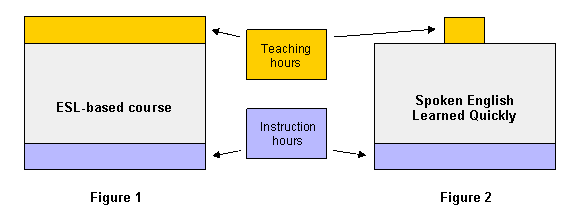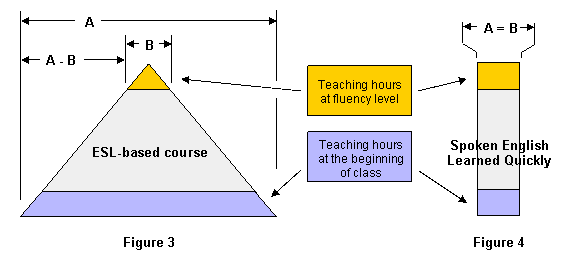Multiply your time
As English language teachers, we are all concerned with time. The more effective the English language teaching method we use, the larger the number of students we will be able to teach during the allotted time.
The time required for students to reach English fluency is important in any English language program. This is true for both the students and the teachers. The students rightly expect to attain fluency with as little wasted time as possible. Equally, the teachers and the teachers’ school expect that the teachers’ time will be well used. This means that for each hour of instruction, the students will make as much progress as possible.
There are two areas in which the efficiency of the English language training program will be particularly apparent:
- The method used must give the student as many hours of spoken English instruction as possible for each hour expended by the teacher.Notice that we stated the goal in terms of spoken English instruction. A teacher may give “homework” assignments in writing and grammar exercises. These assignments will certainly increase the ratio of instruction-hours to teacher-hours. But they will have little effect in producing better English fluency. (See the related discussion under A technical comparison of Spoken English Learned Quickly and ESL courses. This article is the basis for much which is being said in this page.)
- The method used must minimize the amount of loss of the teacher’s time when students fail to apply themselves or drop out of the program.No matter how effective the English language method is, not all students will complete the course or expend sufficient energy to increase their English fluency. Whenever that occurs, whatever individual time the teacher has invested in that student’s language instruction is lost. (Of course, from a humanitarian sense, nothing may be lost. The teacher still gave something of value to the student.)
In the figures below, we will attempt to show how the English language training method has a direct bearing on the amount of time a teacher must expend. These drawings are used for the purpose of illustration only. There is no attempt to give them statistical meaning.
1. The method used must give the student as many hours of spoken English instruction as possible for each hour expended by the teacher.
By design, almost all ESL courses use teacher instruction rather than prerecorded audio instruction as the primary teaching method. When a single student is being taught, the ratio is one hour of the teacher’s time to each hour of instruction. In a class with multiple students, the ratio appears to drop. However, in practicality, when the teacher is talking (or listening) to a single student, the remainder of the students’ learning drops to such a low level that it results in a great deal of wasted time. Again, it is important to remember that we are talking about spoken language instruction.
The result is shown in Figure 1. Using typical ESL programs, the teacher must invest one hour of his or her time for each hour of student instruction time.

The efficiency of this use of the teacher’s time is shown in Figure 2.
2. The method used must minimize the amount of loss of the teacher’s time when students fail to apply themselves or drop out of the program.
Figure 3 illustrates what English language teachers know all too well. In order to have a small number of students reach adequate English fluency (represented in Figure 3 as B), a large number of students (represented as A) begin study but never attain adequate fluency.

Again, however, Spoken English Learned Quickly was designed to overcome this inefficiency. We will assume that the class consists of a group of 10 students. The teacher will only invest two hours into this class each week. Thus, there should be a total of at least 70 hours of spoken English instruction for these students each week. However, if some of the students fail to use the exercises as they should during the week, the time lost is the student’s study time, not the teacher’s class time. Therefore, we represent the fluency level of those who have persisted (B) as being equal to the teaching time (A). We understand that Figure 4 is only representative because the teacher’s total effectiveness is nonetheless decreased when a student does not study. Yet, the loss of the teacher’s time is considerably less when the student is studying with the Spoken English Learned Quickly CD than when all of the teaching takes place during a lesson conducted by a teacher.
A practical application
Every teacher has a finite amount of time. Consequently, the efficiency of the language instruction method will effectively determine how many students he or she can teach. When the method essentially requires an hour of the teacher’s time for each hour of spoken English language instruction, the teacher’s influence per number of students will be severely limited. However, when a tool such as the CD for Spoken English Learned Quickly can be used by the student in independent study, the teacher’s time is more effectively used. A much larger number of students can be taught for the same number of hours of instruction.
Similarly, the objective of many English language programs is to make contact with students. In most ESL programs, there will always be a large time expenditure to accommodate a relatively small number of students on the base A level of Figure 1. By using the self-study Spoken English Learned Quickly CD, much less time is required per student even though the spoken English instruction is superior. As a result, for the same expenditure of time, contact may be made with a larger number of students.